

The below writing is by Glenn Chen a long time Alaska resident and fishing expert with decades of experience fishing Salmon and Steelhead on the Alaska Peninsula and beyond.
IN PURSUIT OF REMOTE CHROME: THE MIGHTY KING SALMON OF THE ALASKA PENINSULA
Glenn Chen © GF Spey 2018
As the big fly swung next to the bank, I felt a soft pluck, followed by a series of increasingly urgent tugs before the tip of my Spey rod was pulled down in a solid arc towards the water’s surface.
Rousted from my early morning reverie, and with mental circuits dulled by too many pre-dawn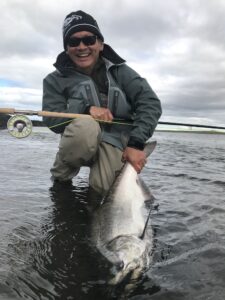 risings, my response to the take was atypically delayed. This turned out to be a good thing, as lack of sleep had intervened to prevent me from yanking the fly away from the fish, before it could fully engulf the faux concoction of shiny tinsel and wiggly feathers wound around tempered steel. Throbbing headshakes were now sending stupendous jolts up the taut line, and the klaxons suddenly sounded off in my head – set the hook now, you darn fool!
risings, my response to the take was atypically delayed. This turned out to be a good thing, as lack of sleep had intervened to prevent me from yanking the fly away from the fish, before it could fully engulf the faux concoction of shiny tinsel and wiggly feathers wound around tempered steel. Throbbing headshakes were now sending stupendous jolts up the taut line, and the klaxons suddenly sounded off in my head – set the hook now, you darn fool!
The resulting reaction from the big chinook that had grabbed the five-inch long, blue and black Stinger Prawn was nothing short of astonishing. There was a momentary stillness that hung in the morning vapor – and then all hell broke loose.
The powerful king salmon bulldozed across the river, easily pulling the nylon running line through the fast current. Reaching the far side, she suddenly decided that her best escape from this unanticipated torment lay in a return back to the sea. The chrome hen instantly set off on a blistering downstream run, with dorsal fin and half of her broad body out of the water, muscling against the tight drag in an amazing display of pure power; my line instantly melted off the reel as if it had been set on free spool. A giant rooster tail of spray, accompanied by sounds of ripping Dacron backing slicing through the water, followed the swiftly vanishing fish.
All I could do was stand there, gripping the bucking rod with mouth agape, momentarily forgetting to breathe. My line hand absently drifted down to the frame of the wildly whirring fly reel, and I suddenly jerked it back in dismay, as the friction-generated heat from the drag scorched me like a red-hot coal.
With over 200 yards of line out in the river, the fish finally decided to stop at the very end of the pool, just before the current broke into the faster water below. The long rod was deeply bent all the way to the grip, and each of her ponderous head shakes generated extreme anxiety about the hook coming undone. A standoff ensued, during which neither of us relaxed nor gave quarter as the stretched line hummed in the heavy flows. For a while, I was beset by despairing thoughts of losing this salmon, until the heavy pressure from my tackle finally began to coax her back upstream, one slow reel crank at a time.
During the long minutes that followed, I gained but then lost line repeatedly, as the struggle continued; at one point in the fight, the chinook made another wild, unstoppable dash back down to the tailout — a display of defiant determination pitted against modern angling technology. Far below me, she rose to the surface, her twisting body and thrashing tail throwing fountains that glinted in the morning light – an awe-inspiring, magnificent sight indeed.
down to the tailout — a display of defiant determination pitted against modern angling technology. Far below me, she rose to the surface, her twisting body and thrashing tail throwing fountains that glinted in the morning light – an awe-inspiring, magnificent sight indeed.
Eventually, my running line and then the Skagit head emerged and were wound back onto the spool, as the salmon’s strength slowly ebbed against the inexorable pull of boron, graphite, and nylon. I hollered to our guide, who came sprinting along the bank towards me to assist with the final touché. Joe assumed the statue-like posture of a patient heron, peering through his polarized glasses and seeking just the right opportunity to slip the net beneath my prize. Several times, I managed to steer the hen’s head towards the waiting mesh and over the net rim — only to watch the chinook flex her powerful tail and dash away. She then made one final, half-hearted run a few yards downstream, floated to the surface, and opened her mouth – whereupon she shook the hook free, leaving us with naught but exasperated stares.
This was my second week of chasing chinook salmon on the Alaska Peninsula, during an extended fly fishing sojourn that took place in early summer of 2017. I had just completed an incredible angling session for sea-bright kings on the nearby Sandy River, and was eagerly looking forward to the possibility of battling yet more chromers on the Sapsuk River.
The ultra-modern, state-of-the-art Pilatus charter aircraft made the short flight from the Sandy to Nelson Lagoon in swift fashion, and as we landed on the gravel airstrip, I saw friendly faces awaiting my arrival. The greeting crew included Kenny, Sharon, and Merle, who were lifelong Alaska Native residents of this small Aleut village; big smiles and hearty handshakes were exchanged with these wonderful folks, whom I had become friends with over my numerous visits to this remote community (located 500 plus miles west of Anchorage).
Through the plane’s window, I had spied my long-time Alaska fishing companion Charlie standing at the edge of the runway; his enormous grin telegraphed the success he’d had during the prior week. I strolled towards him and the small knot of departing anglers to quiz them about river conditions, and also met the two fishers who would be heading up to camp with me: my California friend and Sapsuk regular Mark, and Michael from the UK, both of whom had arrived on an earlier flight from the city. As the plane was unloaded and re-packed, Charlie regaled us with tales of the big salmon he’d hooked and fought – the main run had arrived, and we would be casting over fresh kings during the next 6 days.
With the tide nearing flood stage in the Lagoon, we quickly transferred our gear onto the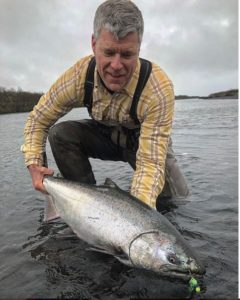 aluminum hulled Nikka D, launched her, and then sped across the chop with Merle at the helm. At the mouth of the river, camp manager/head guide Mike was waiting there to take us upriver to the camp. I greeted my dear friend with a bear hug, and, after piling mounds of fresh provisions, rod cases, and luggage into his jet sled, he promptly fired up the Yamaha outboard, then roared upriver at full throttle for the final leg of our journey.
aluminum hulled Nikka D, launched her, and then sped across the chop with Merle at the helm. At the mouth of the river, camp manager/head guide Mike was waiting there to take us upriver to the camp. I greeted my dear friend with a bear hug, and, after piling mounds of fresh provisions, rod cases, and luggage into his jet sled, he promptly fired up the Yamaha outboard, then roared upriver at full throttle for the final leg of our journey.
As we approached the camp’s boat landing, I saw the familiar face of our delightful cook Kathy standing atop the uppermost platform. I enthusiastically returned her wave and big smile, then saw someone sweep past her and bound nimbly down the steps towards us. The colorful blur morphed into a grinning, bearded young man wearing Terminator-style shades; I turned to Mike, who laughingly introduced me to his new guide. I managed to grab Joe’s hand for a brief handshake between his swift trips carrying the boxes and bags, watching in astonishment as he hauled the weighty items up the steep stairs with alacrity and exuberant bursts of youthful energy.
Having fished at the Sapsuk for autumn coho salmon (Oncorhynchus kisutch) and fall steelhead trout (Oncorhynchus mykiss) during prior seasons, I was eager to test my skills against the larger and more spirited chinook (Oncorhynchus tshawytscha). On the Alaska Peninsula, these monarchs of the Pacific salmon family return to their natal rivers during June and July, ascending to upstream spawning areas and completing their life cycle sometime in mid to late summer. A typical AP king weighs between 18 to 25 pounds, and I had heard prior tales about Sapsuk anglers hooking fish approaching 40 pounds. These chinook were mighty adversaries that were renowned for their awe-inspiring power and incredible stamina, and catching one requires long hours of dedicated effort, and waging pitched battles against formidable strength that was slow to yield. Landing half of the ones you hooked was considered exceptional, with many anglers managing to attain far lower percentages; little wonder, then, that king salmon were atop the pinnacle of species pursued by the international coterie of anadromous salmonid anglers.
Heavy gear is necessary to successfully subdue these ultra-strong fish, which fight like demons incarnate after feeling the sting of a hook. I was equipped with Winston Boron III Spey rods (including a 15’ 9-weight and a 13.5’ 8-weight) and high quality disc drag reels (Loop Evotec and Orvis Hydros; I left my classic Hardys at home, knowing full well that these click-pawl reels would be inadequate for handling the powerful kings). Skagit shooting heads attached to floating running lines, along with an array of sink tips, stout leaders, and an assortment of large attractor flies rounded out my tackle arsenal.
The first day of angling began with the alarm sounding off at 0300, followed by breakfast thirty minutes later, and departure at the onset of first light. Besides Mark, Michael, and I, our camp was fully occupied and included three French anglers, who had booked two consecutive weeks; each trio rotated between the two guides, allowing us to change fishing beats every day.
We drew the upper water and stopped first at the Cabin Corner, a deep pool formed via current scour against a hard clay bank. Casting in the gathering light, I was rewarded with a grab on a chartreuse Bjorn Stinger Prawn during my third swing. I waited for what seemed like excruciatingly long moments as the gentle tugs morphed into steady pulls, culminating in a deep rod arc before I finally jabbed the hook home with a simultaneous sharp yank on the line and swift lifting of the tip. A series of violent headshakes, followed by the hair-raising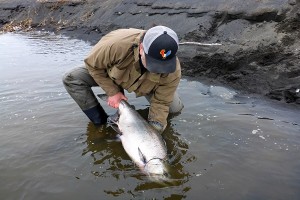 sensation of being attached to an unstoppable moon rocket, ensued as the big buck powered across the hole and sought safety amidst the boulders lying in the tailout. I barely managed to turn him using maximum reel drag and pressure from the stout 9-weight; he eventually returned to the depths of the main pool, seesawing back and forth in the current as I constantly changed rod angles in an effort to confuse him and shorten the fight. Following a 10-plus minute tussle, Joe arrived with the net, and we successfully landed, then gently released, the 25-pound, mint-chrome male chinook.
sensation of being attached to an unstoppable moon rocket, ensued as the big buck powered across the hole and sought safety amidst the boulders lying in the tailout. I barely managed to turn him using maximum reel drag and pressure from the stout 9-weight; he eventually returned to the depths of the main pool, seesawing back and forth in the current as I constantly changed rod angles in an effort to confuse him and shorten the fight. Following a 10-plus minute tussle, Joe arrived with the net, and we successfully landed, then gently released, the 25-pound, mint-chrome male chinook.
After concerted efforts from all three anglers yielded no additional takes, we motored up to the Weir Pool, named for the sockeye salmon counting structure placed at its head by State fisheries managers (used to collect data for monitoring returns of this commercial important species). Hundreds of Chinook can be found here during the peak of the run, rolling on the surface and causing startling disturbances akin to catapulting giant stones into the flows. A reluctance to negotiate the sockeye weir, however, also slows their upstream passage; thus, kings tend hold here for lengthy periods after arriving, becoming darker and disinclined to strike; we therefore hoped that there would newer fish available to bend our rods.
Switching to my 8-weight Spey outfit, I began to work the top of the hole with a series of concentric swings. After casting the heavy 9-weight for hours each day during the prior week, using the lighter rod was a welcome change, and provided some relief to my sore wrist and overly strained forearm… until that beserk henfish grabbed my blue and black Prawn and sprinted off downriver, as if all of the seals in the Bering Sea were chasing her…
I did manage to land my next hookup – an 18-pound, super bright buck – and all of us continued to have grabs by chinook in the Weir Pool throughout the morning, along with an occasional sockeye that somehow managed to stuff the outsized fly into its smallish mouth. Strong gusts would frequently buffet us, and I strained to cast into the stiff headwinds, which at times caused my cast to pile into a tangled heap atop the water. Finally, after a couple of consecutive passes yielded no strikes, we decided to rest the hole, returning to the parked boat to eat Kathy’s tasty sandwiches and homemade cookies, washing down our meals with strong coffee.
While enjoying our lunch, I spied wakes from newly arriving chinook entering the lower tailout, which provided sufficient enticement to resume our efforts post-repast. Swinging our flies past these fresh fish resulted in jarring, arm-wrenching strikes, and swift, greyhound-style dashes that emptied our reels. Sudden changes in direction by the salmon caused large loops of slack to form in our lines, and frantic retrieving to regain contact and a semblance of control were often futile. Joe sprinted up and down the length of the Weir Pool, netting one fish, then huffing away to land another. With the hot and heavy action, the afternoon sped by quickly, and we return back to camp, elated with our first day’s successes.
After a scrumptious roast pork dinner followed by key lime pie for dessert, I decided to check out a hole rumored to be a hotspot. Foot access to this particular DIY location, however, proved to be most challenging – I had to blaze a path through a an unbroken expanse of waist high grass, the dense vegetation constantly entangling my wader clad feet and causing me to stumble frequently on hidden obstacles. The ever-present winds had died down too, and my clumsy passage through the tall growth stirred up clouds of fierce mosquitos that slaked their bloodlust, as I tried in vain to swat them away.
I finally emerged onto the gravel bar and brushed off the last of the persistent ‘skeets,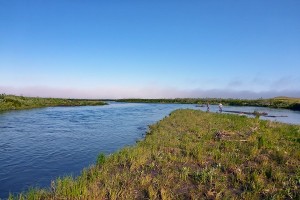 splashing cold water onto my skin to quell the burning itches caused by their feeding. Gazing out onto the river, the thrilling sight of several bright chinook rolling in unison quickly dispelled the torment that I had just endured. I waded in cautiously, working the Skagit head past my rod tip — and was instantly fast to a hot salmon. After beaching him, this initial king was followed by 6 more smash takes on successive casts, including one 30-pound fish that hotly pursued the Stinger Prawn across the surface for a dozen yards with dorsal fin raised high above the water, before savagely clamping his jaws onto my fly… the torrid action continued for an hour as I worked my way to the end of the run, until things finally slowed.
splashing cold water onto my skin to quell the burning itches caused by their feeding. Gazing out onto the river, the thrilling sight of several bright chinook rolling in unison quickly dispelled the torment that I had just endured. I waded in cautiously, working the Skagit head past my rod tip — and was instantly fast to a hot salmon. After beaching him, this initial king was followed by 6 more smash takes on successive casts, including one 30-pound fish that hotly pursued the Stinger Prawn across the surface for a dozen yards with dorsal fin raised high above the water, before savagely clamping his jaws onto my fly… the torrid action continued for an hour as I worked my way to the end of the run, until things finally slowed.
The setting sun and dwindling light suddenly reminded me that my return trek would necessitate traversing through spots with limited visibility, coinciding with onset of crepuscular activities by the brown bears. The resident bruin – an exceptionally large boar nicknamed Yogi – ruled this section of river as his fiefdom, and I did not want to dispute his territorial claim, so I turned my back on the still-rolling kings and resumed my role as the moving feast for the nasty micro-vampires.
The next day arrived accompanied by overcast skies, receding flows, and increasing water clarity. Mike took us to the Mojo Hole, and I was soon rewarded with a massive, bear-trap strike. Vivid flashes of bright chrome rose from the depths as the huge buck twisted fiercely, straining mightily against the 9-weight Winston. We eventually landed him downstream of the parked jet sled, with Mike managing to just barely squeeze the big fish into the net. As he lay spent within the meshes, both of us marveled at the sight of his massive head, enormous girth, and giant spotted tail; the digital scale subsequently confirmed my weight estimate (35 pounds).
The Mojo Hole starts as a deep churning whirlpool at its head, makes a hard right turn along a high clay bank, and then runs straight for more than 75 yards before entering the Aquarium (aptly named for the dozens of fish that collect there in its gentle eddies, finning in plain sight). The lower portion of Mojo is bordered by live alders and submerged trees along its deepest side; naturally, the salmon concentrate where these hazards are most dense, and so fishing this spot requires the utmost of Zen patience, as you attempt to work your pattern through the thicket of unseen snags. I ended up sacrificing three flies here, before I felt the unmistakable pull of another big king swimming away with my purple Prawn. The 20-pound salmon remained deep during the fight, always pulling hard towards the safety of the sunken brush; I winced as I felt my leader scraping against underwater branches. Bending the rod in Spey harikari fashion, and locking the reel spool with my free hand, I applied pressure maximus to the fish. Fortunately, the Winston withstood the excessive force, and this king eventually swam free of the obstacles, allowing himself to be pulled into the shore, a silver torpedo finning tiredly at my feet.
As the week progressed, river levels continued to drop and clear, which further slowed the upstream movements of fresh chinook. We still managed to catch some chrome-sided fish on our initial passes through each pool, albeit the ratio of takes to casts declined noticeably. The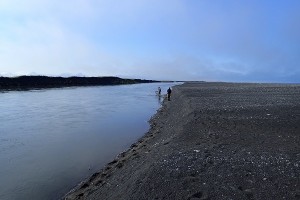 longer waits between grabs had the unfortunate effect of increasing the frequency of blown hookups, as my responses grew ever more hair-trigger. I ended up having to take a serious chill break, after failing to provide the all-so-important delays that inevitably resulted in a maddening series of fruitless hook sets. Resuming my recitation of “God Save The Queen and Prince Charles!” before striking eventually rewarded me with the satisfying sensation of a well-hooked chinook surging away, attached to my bucking rod and whirring reel.
longer waits between grabs had the unfortunate effect of increasing the frequency of blown hookups, as my responses grew ever more hair-trigger. I ended up having to take a serious chill break, after failing to provide the all-so-important delays that inevitably resulted in a maddening series of fruitless hook sets. Resuming my recitation of “God Save The Queen and Prince Charles!” before striking eventually rewarded me with the satisfying sensation of a well-hooked chinook surging away, attached to my bucking rod and whirring reel.
I alternated between fishing the slower, deep pools where the adult kings were holding, and shallower runs that were dominated by smaller jack chinook. The latter are sexually mature, albeit precocious males that return to the river after a brief marine sojourn, and thus do not attain the full size achieved by the rest of their cohort (which will remain at sea for as long as five years). They serve a crucial role as a form of reproductive warranty, to ensure that the eggs of every female salmon arriving on the spawning grounds will be fertilized. These fish are eager biters, albeit shouts of initial glee often turn into disappointed grumbles when the angler realizes that he has hooked a “(insert expletive) jack”. As for me, I welcome their ferocity and stubborn tenacity, and I rarely forego an opportunity to swing a fly in front of such mini-kings.
During the last two days of our trip, the guides decided to focus fishing efforts on the lower beats, in the hopes of intercepting newly arrived kings that were more willing to bite. This proved to be a wise strategy – angling action improved, and we were subsequently able to hook (and sometimes land) a number of chrome-sided chinook with sea lice still attached to their bodies.
I recall an arm-wrenching strike from a bright 35-pound buck that ravenously attacked my pink Prawn, moments after it landed on the water; this crazed salmon strained my tackle and nerves to the utmost, reluctantly surrendering to the net only after a pitched battle, and dousing us with water upon release (employing the piscine version of a raised middle finger). A less glorious — and considerably more humbling — memory was of a big hen that slowly approached, then leisurely ingested my fly as it sank beneath coils of line stacked atop the surface (the result of an errant cast thrown back at me by a gust of wind). As I watched her chewing on my offering in the clear water, I frantically stripped in slack before finally coming tight on this fish; she eventually earned her freedom right at the net, swatting the annoying Prawn loose from her jaw with a disdainful slap of her huge tail against the outstretched leader.
Folks who don’t desire to feel the brute strength, wild power, and uncontrollable panic associated with hooking a river king salmon that had been swimming in the boundless ocean a few hours earlier… should just stick to catching resident trout.
We spent our final day parked at the lowermost pools where upstream migrating kings first stopped to rest. This was an “ambush game” that was rewarded at periodic intervals between patient waiting, concerted casting efforts, and frequent fly changes. While I managed to land several hefty kings – including a 32-pound, copepod-decorated brute that immediately blasted downstream and tore line off the reel following his ferocious grab – Mark was the hot stick, hooking up on consecutive passes after he switched to a heavier pattern (weighted with a large brass cone head) that enabled him to better entice the fish holding in the deeper parts of these runs.
Heading back to camp, I asked Mike drop me off at a favorite spot for a final session. I fished thoroughly and patiently through the entire length of this pool, with nary a touch. Reaching the tailout, I let my Prawn fly dangle, swimming back and forth in the eddying current, in the hopes of enticing one last fish. My musings were pleasantly interrupted by a jolting strike – the enormous, chrome-sided buck thrashed violently at the surface, then cartwheeled end over end after feeling the offending hook. I managed to regain my wits and somehow remained attached to this out-of-control salmon, eventually parrying his wild runs until I was able to slide him into the gravel shallows. I placed my Winston Spey alongside, and noted that his snout extended nearly to the first stripper guide; back at camp, we used a tape to measure this length, and concluded that the fish’s weight was somewhere in the high 30’s.
The return to Nelson Lagoon proceeded in orderly fashion (which isn’t always the case – strong winds can result in big waves on the Lagoon, making it impassable; flight delays due to nasty weather occur frequently as well). I bid farewell to Kathy, Mike, and Joe; after days of wearing sunglasses and with the reflected sunlight browning the exposed parts of my face, I had acquired a vivid “raccoon mask” which evoked barely-concealed guffaws from the camp staff.
We were treated to clear skies during our flight back to Anchorage. The numerous streams and rivers flowing into the Bering Sea that passed beneath our wings sent their siren beckons to me… surely some of these must hold little-fished runs of chrome, anadromous salmonids (!). My dreams of mounting a scientific expedition to document the distribution and abundance of chinook, coho, and steelhead along the Alaska Peninsula will need to become reality, someday…